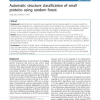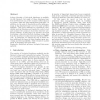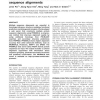262 search results - page 14 / 53 » Protein secondary structure prediction using neural networks |
BMCBI
2010
13 years 9 months ago
2010
Background: Random forest, an ensemble based supervised machine learning algorithm, is used to predict the SCOP structural classification for a target structure, based on the simi...
CIBCB
2005
IEEE
14 years 2 months ago
2005
IEEE
— Part of the challenge of modeling protein sequences is their discrete nature. Many of the most powerful statistical and learning techniques are applicable to points in a Euclid...
ADC
2007
Springer
14 years 3 months ago
2007
Springer
A huge diversity of biological databases is available via the Internet, but many of these databases have been developed in an ad hoc manner rather than in accordance with any data...
BMCBI
2004
13 years 9 months ago
2004
Background: Because loops connect regular secondary structures, analysis of the former depends directly on the definition of the latter. The numerous assignment methods, however, ...
NAR
2007
13 years 8 months ago
2007
Multiple sequence alignments are essential in homology inference, structure modeling, functional prediction and phylogenetic analysis. We developed a web server that constructs mu...



